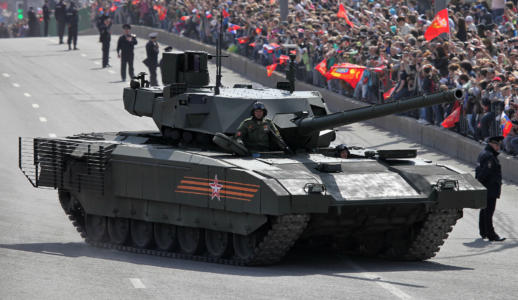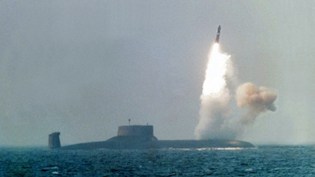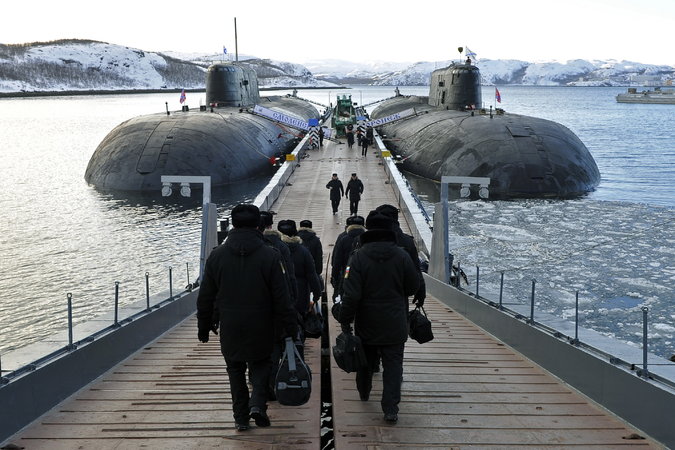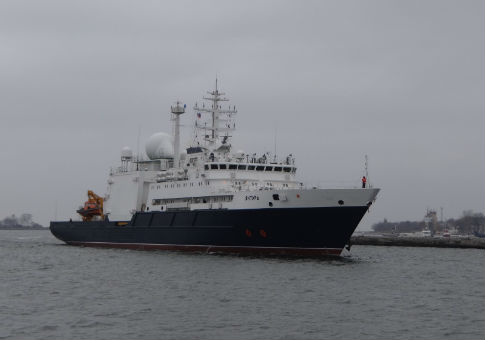Russia is Preparing For War

The Russian Armata tank
The T-14 Armata is a new Russian main battle tank based on the Armata Universal Combat Platform. It was first seen in public (initially with its turret and cannon shrouded) during rehearsals for the 2015 Moscow Victory Day Parade.
The Russian army plans to acquire 2,300 T-14s in the period 2015-2020. The tank has an unmanned remotely controlled turret. It is equipped with a deadly laser-guided anti-tank missile.
The evidence that Russia is preparing for war can be found in the Kremlin’s constant anti-America propaganda over the state media. The Russians are hearing daily propaganda that states that the United States wants to destroy Russia. As Nyquist and Baruch have indicated, Russia is getting their population ready for war against the United States and its NATO allies.
The nuclear forces build-up under Putin has changed the balance of power and currently Russia has nuclear supremacy over the United States and its allies
Bill Gertz wrote an article titled “Russia Doubling Nuclear Warheads” which was published in the Accuracy in Media website on April 1, 2016. He said that “Russia is embarked on a major strategic nuclear forces build-up under Putin. Moscow is building new road-mobile, rail-mobile, and silo-based intercontinental-range missiles, along with new submarines equipped with modernized missiles. A new long-range bomber is also being built.”

Russia fires SS-N 30 from one of its submarines.
On March 10, 2016, Admiral Cecil Haney, commander of the U.S. Strategic Command which is in charge of nuclear forces, told Congress the following: “Russia’s modernization program and their nuclear deterrent force are of concern. When you look at what they’ve been modernizing, it didn’t just start. They’ve been doing this quite frankly for some time with a lot of crescendo of activity over the last decade and a half.”

Admiral Cecil D. Haney is Commander of U.S. Strategic Command (USSTRATCOM), one of nine Unified Commands under the Department of Defense. USSTRATCOM is responsible for the global command and control of U.S. strategic forces to meet decisive national security objectives, providing a broad range of strategic capabilities and options for the President and Secretary of Defense.
President Obama has not modernized the aging U.S. nuclear forces and for seven years. Additionally, he has made sharp defense spending cuts. The president has stated that he wants to eliminate eventually all nuclear weapons from the United States. Now, the Pentagon is scrambling to find funds to modernize aging U.S. nuclear forces. In addition to a large-scale nuclear buildup and the improvement of other weapons systems, Russia has repeatedly threatened to use nuclear arms against the United States in recent months, compounding fears of a renewed Russian threat.
Earlier in March 2016, General Joseph Dunford, chairman of the Joint Chiefs of Staff, told Congress that Russia continues to pose the greatest threat to the United States. General Dunford stated the following: “The one that has the greatest capability and poses the greatest threat to the United States is Russia because of its capabilities—its nuclear capability, its cyber capability, and clearly because of some of the things we have seen in its leadership behavior over the last couple of years.”

General Joseph Dunford is chairman of the Joint Chiefs of Staff.
Bill Gertz explained that Mark Schneider, a former Pentagon official involved in strategic nuclear forces, said he has warned for years that Russia is not reducing its nuclear forces under the treaty. Since the New START arms accord, Moscow has eliminated small numbers of older SS-25 road-mobile missiles. However, the missiles were replaced with new multiple-warhead SS-27s.
Russian Topol M SS27 Sickele B ICBM is road-mobile that carries an 800 kiloton nuclear warhead. It is far superior to anything possessed by the United States. The SS-27 road-mobile ICBM will be armed with 10 warheads.
Gertz wrote that Russian officials deceptively sought to make it appear that their nuclear forces have been reduced during a recent nuclear review conference. Yet, the deployment of new multiple-warhead SS-27s and SS-N-32s are pushing up the Russian warhead numbers. Published Russian reports have stated that the missiles will be armed with 10 warheads each. In addition, Russia is building a new heavy Intercontinental Ballistic Missile (ICBM) called Sarmat, code-named SS-X-30 by the Pentagon, that will be equipped with 10 to 15 warheads per missile. A new rail-based ICBM is being developed that will also carry multiple warheads. Another long-range missile, the SS-X-31, is under development and will carry up to 12 warheads.

Russian Topol M SS27 Sickele B ICBM
Sadly, these new weapons are much better than those of the United States. The United States does have road-mobile ICBMs. Obama has failed in protecting the national security of the nation.
Bill Gertz concluded his article by stating the following: “The White House said Moscow’s failure to take part in the nuclear summit was a sign of self-isolation based on the West’s sanctions aimed at punishing Russia for the military takeover of Ukraine’s Crimea. A Russian official said the snub by Putin was directed at Obama. This summit is particularly important for the USA and for Obama—this is probably why Moscow has decided to go for this gesture and show its outrage with the West’s policy in this manner, Alexei Arbatov, director of the Center for International Security at the Russian Academy of Sciences, told the business newspaper Vedomosti. A Russian Foreign Ministry official, Mikhail Ulyanov, told RIA Novosti that the summit was not needed There is no need for it, to be honest, he said, adding that nuclear security talks should be the work of nuclear physicists, intelligence services, and engineers. The political agenda of the summits has long been exhausted.”
Russia is expanding its submarine fleet
In spite of economic difficulties, Russia has spent billions of dollars to build modern diesel and nuclear-powered attack submarines that are quieter, better armed, and operated more efficiently by Russian sailors than in the past. These state-of-the-art submarine patrols have increased by more than 50% over the previous year.
Eric Schmitt wrote an article titled “Russia Bolsters its Submarine Fleet, and Tensions with U.S. Rise” which was published in the New York Times on April 20, 2016. He pointed out that the increase of Russian submarine patrols are seen by Pentagon officials as a direct challenge to the United States and NATO. Navy officials said that the increase number of Russian submarines, with their ability to follow United States and European ships, will require the construction of more ships, submarines, and aircrafts to monitor the Russian submarines.
As already indicated, Russian dictator Vladimir Putin has modernized Russia’s nuclear weapons, aircraft, tanks, and antiballistic defense systems. A new Cold War has already started and the United States national security is seriously endangered, especially with this president who has cut the Pentagon’s budget to pieces.

Russian state-of-the-art nuclear-power submarines at a northern Russian’s base
Schmitt explained that the Department of Defense has requested $8.1 billion over the next five years to improve “undersea capabilities,” including nine new Virginia-class attack submarines that can carry up to 40 Tomahawk cruise missiles, more than triple the capacity now. The United State has 53 attack submarines, all nuclear-powered, as well as four other nuclear-powered submarines that carry cruise missiles and Special Operations Forces. Navy officials believed that United States attack submarines are superior to the Russian submarines.

U.S.Virginia-class nuclear-powered submarines can carry up to 40 Tomahawk cruise missiles.
Schmitt said that Navy officials are concerned that more Russian submarine patrols will be pushed out beyond the Atlantic into the Mediterranean and the Black Sea. Russia currently has one Mediterranean base in Tartus, Syria. However, Navy officials have said that Russia wants to establish other bases in Cyprus, Egypt, and even Libya. Similar to the United States, Russia has nuclear-powered submarines with intercontinental ballistic missiles that spend months at a time hiding in the depth of the ocean.

Rear Admiral Frederick J. Roegge, commander of the Navy’s submarine fleet in the Pacific stated that “I’m worried every day about what the Russians may be doing” in regards about possible Russian plans for cutting the undersea cables.
David E. Sanger and Eric Schmitt wrote an article entitled “Russian Ships Near Data Cables Are Too Close for U.S. Comfort” which was published in the New York Times on October 25, 2015. The reporters explained that the alarm by Pentagon officials is that Russia could cut the fiber-optic cables at some of their hardest-to-access locations to halt the instant communications on which the citizens, economies and governments of United States and the West are so dependent.
Sanger and Schmitt pointed out that senior American and allied military and intelligence officials have also been extremely concerned over the accelerated activity by Russian armed forces around the globe. Inside the Pentagon and the nation’s spy agencies, the assessments of Russia’s increasing naval activities are highly classified and not publicly discussed in detail. United States officials have not disclosed what they are doing both to monitor the activity and to find ways to recover quickly if cables are cut. However, more than a dozen officials confirmed in broad terms that it had become the source of significant attention in the Pentagon. Commander William Marks, a Navy spokesman in Washington, D. C. said: “It would be a concern to hear any country was tampering with communication cables; however, due to the classified nature of submarine operations, we do not discuss specifics.”
However, Navy and intelligence officials reported that from the North Sea to Northeast Asia and even in waters closer to American shores, they are monitoring significantly increased Russian activity along the known routes of the cables, which carry the lifeblood of global electronic communications and commerce.

The Russian spy ship Yantar
Sanger and Schmitt said that on September 2015, the Russian spy ship Yantar, which is equipped with two self-propelled deep-sea submersible craft, cruised slowly off the East Coast of the United States on its way to Cuba — where one major cable lands near United States Gitmo naval base at Guantánamo Bay. The Russian ship was monitored constantly by American spy satellites, ships and planes. Navy officials said the Yantar and the submersible vehicles it can drop off its decks have the capability to cut cables miles down in the sea. In regards to the increased Russian naval activity, Admiral James Stavridis, formerly NATO’s top military commander and now dean of the Fletcher School of Law and Diplomacy said that “this is yet another example of a highly assertive and aggressive regime seemingly reaching backwards for the tools of the Cold War, albeit with a high degree of technical improvement.”

Admiral Mark Ferguson serves as the commander of Allied Joint Force Command located in Naples, Italy.
Admiral Mark Ferguson directs a combined NATO staff responsible for planning, preparing and conducting military operations throughout the Supreme Allied Commander Europe’s area of responsibility. He concurrently serves as Commander, U.S. Naval Forces Europe and U.S. Naval Forces Africa. His area of responsibility encompasses the waters bordering the coasts of Europe and Africa, including the Baltic, Mediterranean and Black Seas.
Sanger and Schmitt wrote that Admiral Mark Ferguson citing public remarks by the Russian Navy chief, Admiral Viktor Chirkov said the intensity of Russian submarine patrols had risen by almost 50 % over the last year. Admiral Ferguson said that the proficiency and operational tempo of the Russian submarine force was increasing. Admiral Ferguson pointed out that Russian Arctic bases and their $2.4 billion investment in the Black Sea Fleet expansion by 2020 demonstrate their commitment to develop their military infrastructure on the flanks. He also said that Russia is also building an undersea unmanned drone capable of carrying a small, tactical nuclear weapon to use against harbors or coastal areas.
The reporters explained that Admiral Ferguson said that as part of Russia’s emerging doctrine of so-called hybrid warfare, it is increasingly using a mix of conventional force, Special Operations mission and new weapons in the 21st-century battlefield. Admiral Ferguson stated that “This involves the use of space, cyber, information warfare and hybrid warfare designed to cripple the decision-making cycle of the alliance,” referring to NATO. He added that “At sea, their focus is disrupting decision cycles.”
United States allies are also very worried. “The level of activity,” a senior European diplomat said, “is comparable to what we saw in the Cold War.” Norway, a United States ally and a member of NATO, is so concerned that it has asked its neighbors for aid in tracking Russian submarines.
The expanding naval operations are consistent with Russia’s expanding military operations into places like Crimea, eastern Ukraine and Syria, where Russian dictator Vladimir Putin has sought to demonstrate a much longer reach for Russian ground, air and naval forces.
Sanger and Schmitt wrote that Michael Sechrist, a former project manager for a Harvard-M.I.T. research project funded in part by the Defense Department stated the following: “The risk here is that any country could cause damage to the system and do it in a way that is completely covert, without having a warship with a cable-cutting equipment right in the area. Cables get cut all the time — by anchors that are dragged, by natural disasters.” Sechrist published a study in 2012 of the vulnerabilities of the undersea cable network. However, most of those cuts take place within a few miles from shore, and can be repaired in a matter of days. What worries military officials most is that “the Russians appear to be looking for vulnerabilities at much greater depths, where the cables are hard to monitor and breaks are hard to find and repair.”
Michael Sechrist pointed out that the locations of the cables are hardly secret. “Undersea cables tend to follow the similar path since they were laid in the 1860s,” he said, because the operators of the cables want to put them in familiar environments under longstanding agreements. Pentagon officials said that the exceptions are special military cables, with secret locations that do not show up on widely available maps and it is possible the Russians are hunting for those.
Sanger and Schmitt wrote the following: “The role of the cables is more important than ever before. They carry global business worth more than $10 trillion a day, including from financial institutions that settle transactions on them every second. Any significant disruption would cut the flow of capital. The cables also carry more than 95 % of daily communications. So important are undersea cables that the Department of Homeland Security lists their landing areas — mostly around New York, Miami and Los Angeles — at the top of its list of critical infrastructure. Attention to underwater cables is not new.”
The reporters added the following: “In October 1971, the American submarine Halibut entered the Sea of Okhotsk north of Japan, found a telecommunications cable used by Soviet nuclear forces, and succeeded in tapping its secrets. The mission, code-named Ivy Bells was so secret that a vast majority of the submarine’s sailors had no idea what they had accomplished. The success led to a concealed world of cable tapping. And a decade ago, the United States Navy launched the submarine Jimmy Carter, which intelligence analysts say is able to tap undersea cables and eavesdrop on communications flowing through them. American concern over cable cutting is just one aspect of Russia’s modernizing Navy that has drawn new scrutiny.”
There is no question in this writer’s mind that if Russia or China win the race to develop effective hypersonic weapons, both allied nations would use these weapons in a surprise attack to destroy the United States if this nation is unable to retaliate. Russia, China, and their allies would like to destroy and conquer the United States if they could.
As indicated earlier, in mid April 2016, during a hearing of the House of Representatives Armed Services Strategic Forces Subcommittee, Missile Defense Agency Director Vice Admiral James Syring was asked whether his agency is working to counter the threats from Chinese and Russian hypersonic strike weapons. The admiral said, that “I’ve asked for $23 million to begin a low-power laser demonstrator this year to demonstrate the feasibility by 2021.”
This is outrageous! Russia and China are spending billions to develop a weapon that could wipe out the Unites States out of the face of the planet and the Pentagon is requesting $23 million to counter this existential threat to our survival. Congress should prepare a bill appropriating billions to develop an improved hypersonic glider strike weapon over what the Chinese and Russian have or are building. Additionally, the Pentagon should conduct cyber-attacks to steal the hypersonic glider technology from Russia and China. After all both of these two enemy countries have stolen our most precious industrial and military secrets for years!
Obama should have followed Governor Mitt Romney’s recommendation to increase defense spending by $150 billion a year in order to make U.S. armed forces stronger and more capable of protecting this country from its enemies. China and Russia are drastically increasing their defense spending and modernizing their armed forces.
President Obama needs to change his course quickly and start being stronger with our enemies with more assertive foreign and national security policy. Otherwise, our country will continue to be a world superpower in retreat. We could expect more aggression from Russia, China, and other enemy nations over the last year left of the disastrous presidency of Barack Obama.
When aggression is not challenged with firmness, it invites more aggression. Obama and Congress need to increase drastically the budget of the Pentagon and improve the nuclear arsenal and missiles to match or exceed the better-equipped Russian missiles and other weapons. Anti-ballistic missile defense must be improved. Failure to do so will severely endanger our national security. It might provoke a devastating combined Russian and Chinese surprise nuclear attack upon our beloved country as weakness invite aggression from the psychopaths who rule those two nations.
RUSSIAN MILITARY POWER REVIEW:
CHINESE MILITARY BUILDUP (NEXT)
